 Last additions - Chuo-ku 中央区 Last additions - Chuo-ku 中央区 |
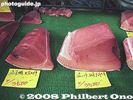
Caught in the Pacific Ocean.Apr 07, 2008
|
|
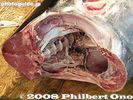
Where the head was attached.Apr 07, 2008
|
|
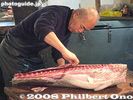
Apr 07, 2008
|
|

Cutting up a fresh fish. They use a long, sharp knife, and not a band saw.Apr 07, 2008
|
|
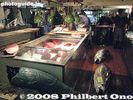
The fresh tuna is cut up into smaller blocks.Apr 07, 2008
|
|
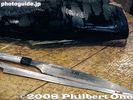
Tuna knivesApr 07, 2008
|
|

After the fish is cut, they shave it with an ax.Apr 07, 2008
|
|
|
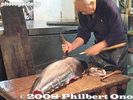
I wonder how long it takes to be able to cut up a giant tuna.Apr 07, 2008
|
|
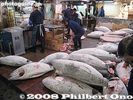
Quite a few more to cut up.Apr 07, 2008
|
|
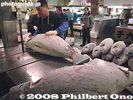
The frozen tuna is cut up into quarters lengthwise by a band saw.Apr 07, 2008
|
|
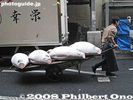
Good exercise in the morning.Apr 07, 2008
|
|
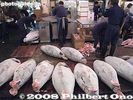
Apr 07, 2008
|
|
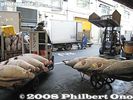
Apr 07, 2008
|
|
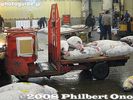
Smaller trolley for a smaller haul.Apr 07, 2008
|
|
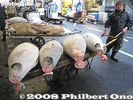
Hand-drawn cart, good for four fish.Apr 07, 2008
|
|
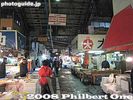
The fish is taken to the fish stalls in the market.Apr 07, 2008
|
|
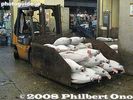
All full and ready to go. Gee, how much is all that tuna worth??Apr 07, 2008
|
|

Hand-drawn cart.Apr 07, 2008
|
|
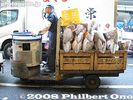
Apr 07, 2008
|
|
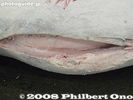
Looks yummy.Apr 07, 2008
|
|
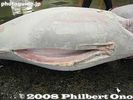
Tuna belly, the fatty part of the fish for toro sashimi.Apr 07, 2008
|
|
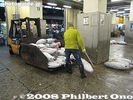
Hauling these tuna on this lift looked easy.Apr 07, 2008
|
|
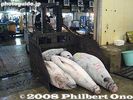
After the auctions are over, they haul out the fish using a variety methods.Apr 07, 2008
|
|
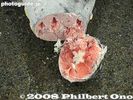
Looks good to me.Apr 07, 2008
|
|
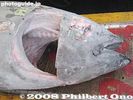
Frozen tuna headApr 07, 2008
|
|
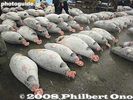
Each fish is worth thousands or tens of thousands of US dollars.Apr 07, 2008
|
|

Apr 07, 2008
|
|
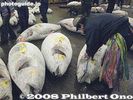
Tying a ribbon on fish.Apr 07, 2008
|
|
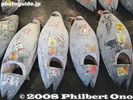
Apr 07, 2008
|
|
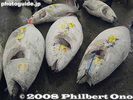
Apr 07, 2008
|
|
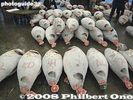
These frozen fish did not show any signs of melting. Wonder how long it takes for them to defrost.Apr 07, 2008
|
|
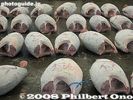
Headless frozen tuna.Apr 07, 2008
|
|
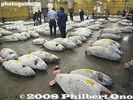
Frozen tuna anyone?Apr 07, 2008
|
|
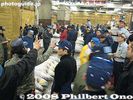
Frozen tuna auctions. Buyers signal the auctioneer. Also see my YouTube video here.Apr 07, 2008
|
|
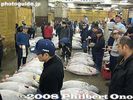
Frozen tuna auctions at Tsukiji Fish Market.Apr 07, 2008
|
|
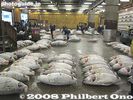
Apr 07, 2008
|
|

Tuna headApr 07, 2008
|
|
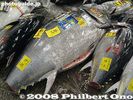
Apr 07, 2008
|
|

Apr 07, 2008
|
|
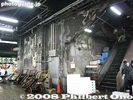
The market building has many signs of its old age.Apr 07, 2008
|
|
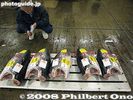
Headless tuna carcassesApr 07, 2008
|
|
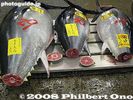
Tails are cut off to show the flesh color.Apr 07, 2008
|
|
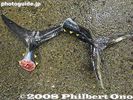
Cut-off tailsApr 07, 2008
|
|
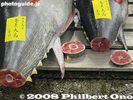
Buyers check the color of the flesh to determine how fatty the fish is.Apr 07, 2008
|
|
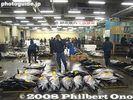
There is no map of the place so you may or may not find the tuna auctions. It's also easy to get lost in the market. This is the fresh fish tuna storage area.Apr 07, 2008
|
|
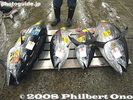
These fish can be huge, bigger and heavier than a sumo wrestler.Apr 07, 2008
|
|
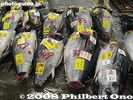
All the fish are labeled. They might indicate where the fish was caught (or raised).Apr 07, 2008
|
|
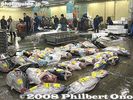
Never saw this much tuna in my life.Apr 07, 2008
|
|

Watch out for these speeding trolleys. They are almost everywhere.Apr 07, 2008
|
|
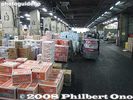
The market is near Tsukijishijō Station on the Toei Ōedo Line and Tsukiji Station on the Tokyo Metro Hibiya Line. The first subway arrives at around 5:20 am. First you walk through the fruit section..Apr 07, 2008
|
|

Fruit section.Apr 07, 2008
|
|
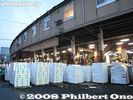
Officially called the Tokyo Metropolitan Central Wholesale Market, this sprawling complex handles mainly fish, but also fruits and vegetables. This is outside the market building.Update: Tsukiji Fish Market closed on Oct. 6, 2018 since it moved to Toyosu. These pictures were taken when toursts were still free to roam around the auction area and inner market. Now a blast from the past. Sorry you missed it.Apr 07, 2008
|
|

Plum blossomsDec 11, 2007
|
|

Dec 11, 2007
|
|

Plum blossomsDec 11, 2007
|
|

CamelliasDec 11, 2007
|
|

CamelliasDec 11, 2007
|
|

Duck-hunting wallDec 11, 2007
|
|

Tiny slits to look at the ducksDec 11, 2007
|
|

Former boat landing for the shogunDec 11, 2007
|
|

Shiodome skyscrapers overwhelm the little tea houseDec 11, 2007
|
|

CamelliaDec 11, 2007
|
|

Sightseeing boat pierDec 11, 2007
|
|

Tea house, pond, and pine treeDec 11, 2007
|
|

Dec 11, 2007
|
|

Nakajima-no-Ochaya Tea HouseDec 11, 2007
|
|

Duck hunting gutterDec 11, 2007
|
|

Nakajima-no-Ochaya Tea HouseDec 11, 2007
|
|

Dec 11, 2007
|
|

Nakajima-no-Ochaya Tea House on the small island in the pond.Dec 11, 2007
|
|

Dec 11, 2007
|
|

Dec 11, 2007
|
|

Dec 11, 2007
|
|

The garden would look better without all these skyscrapers in the background.Dec 11, 2007
|
|

Straw band wrapped around the pine tree trunk to catch bugs crawling on the trunk.Dec 11, 2007
|
|

Dec 11, 2007
|
|

Dec 11, 2007
|
|

Dec 11, 2007
|
|

Dec 11, 2007
|
|

Dec 11, 2007
|
|

Dec 11, 2007
|
|

Dec 11, 2007
|
|

Dec 11, 2007
|
|

Dec 11, 2007
|
|

Pine trees along the shoreDec 11, 2007
|
|

Dec 11, 2007
|
|

Otsutaibashi Bridge over the pond.Dec 11, 2007
|
|

Dec 11, 2007
|
|

Otsutaibashi BridgeDec 11, 2007
|
|

Shiori-no-Ike PondDec 11, 2007
|
|

Shiori-no-Ike Pond with ducks. This is a tidal pond.Dec 11, 2007
|
|

Dec 11, 2007
|
|

Another entranceDec 11, 2007
|
|

Dec 11, 2007
|
|

Dec 11, 2007
|
|

Dec 11, 2007
|
|

Dec 11, 2007
|
|

Another entranceDec 11, 2007
|
|

This was the entrance and bridge which the Emperor passed through when visiting the garden.Dec 11, 2007
|
|

Dec 11, 2007
|
|

A small garden and little stream which was behind the Enryokan State Guesthouse.Dec 11, 2007
|
|

Dec 11, 2007
|
|

English explanation for yuki-zuri which are those strings propping up the pine tree branches as a countermeasure against snow.Dec 11, 2007
|
|

Many pine trees in the gardenDec 11, 2007
|
|

Gingko tree and pine tree in autumnDec 11, 2007
|
|

Gingko tree in autumnDec 11, 2007
|
|

Gingko tree and pine tree in autumnDec 11, 2007
|
|

Walking through the Enryokan site, now dotted with pine trees.Dec 11, 2007
|
|

Dec 11, 2007
|
|

The U-shaped Enryokan was used as a guest house until 1883 when the new Rokumeikan 鹿鳴館 guest house was completed. Due to old age, the Enryokan was torn down in 1889. Many new Shiodome skyscrapers loom over the site.Dec 11, 2007
|
|

Site of the Enryokan State Guesthouse. Under former Tokyo Governor Masuzoe, Tokyo had plans to faithfully reconstruct the Enryokan in time for the 2020 Tokyo Olympics. Plan has been shelved.Dec 11, 2007
|
|

Site of the Enryokan State Guesthouse. Built in May 1869, it was Japan's first Western-style building made of stone. It served as an office of the Japanese navy before it was refitted as guest house. 延遼館Dec 11, 2007
|
|

Dec 11, 2007
|
|

Site of the Enryokan State Guesthouse. Former U.S. President Ulysses Grant and his wife stayed there for two months in 1879 during their world tour. Hawaii's King Kalakaua also stayed here in 1881. He traveled by horse carriage to meet Emperor Meiji.Dec 11, 2007
|
|

Side view of 300-year-old pine treeDec 11, 2007
|
|

300-year-old pine treeDec 11, 2007
|
|

Huge 300-year-old pine treeDec 11, 2007
|
|

300-year-old pine treeDec 11, 2007
|
|

Map of Hama-rikyu Gardens. Main entrance is on the upper left corner.Dec 11, 2007
|
|

Entrance to Hama-rikyu Onshi GardensDec 11, 2007
|
|

Marker indicating the garden as a sightseeing spot and Special Historic Site.Dec 11, 2007
|
|

MoatDec 11, 2007
|
|

Bridge to Hama-rikyu Gardens. Guests staying at the Enryokan State Guesthouse during the 19th century would cross this bridge.Short walk from JR Shimbashi Station and Shiodome Station on the Oedo Subway Line and the Yurikamome line.Dec 11, 2007
|
|

Moat with Tsukijigawa RiverDec 11, 2007
|
|

Hama-rikyu Onshi Teien Gardens is a waterfront garden built by the Tokugawa shoguns in the 17th century. During the Meiji Period, it became a Detached Palace for the Imperial family who gave the garden to the Tokyo in 1945. It used to have duck-hunting grounds. It was also the site of the Enryokan State Guesthouse where foreign dignitaries stayed such as former US president Ulysses Grant and Hawaii's King David Kalakaua.Dec 11, 2007
|
|

Chuo-dori avenue looking toward Nihonbashi Bridge.Jan 27, 2007
|
|

Nihonbashi Bridge ahead, with the expressway over it.Jan 27, 2007
|
|

Distances from the Zero Milestone to major cities such as Chiba, Mito, and Sapporo.Jan 27, 2007
|
|

Distances from the Zero Milestone to major cities such as Yokohama, Kyoto, and Kagoshima.Jan 27, 2007
|
|

Japan's Zero Milestone 日本国道路元標Jan 27, 2007
|
|

Memorial square for the Zero Milestone for the Five Major RoadsJan 27, 2007
|
|

Jan 27, 2007
|
|

Jan 27, 2007
|
|

Jan 27, 2007
|
|

Jan 27, 2007
|
|

Jan 27, 2007
|
|

Japan's Zero Milestone for Roads 日本国道路元標Jan 27, 2007
|
|

Jan 27, 2007
|
|

Looking toward Nihonbashi on Chuo-doriJan 27, 2007
|
|
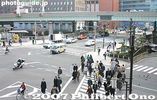
Nihonbashi as seen from Mitsukoshi Dept. Store.Jan 27, 2007
|
|

Bridge lampsJan 27, 2007
|
|

Jan 27, 2007
|
|

Expressway above the bridge.Jan 27, 2007
|
|

Sky roofJan 27, 2007
|
|

Nihonbashi RiverJan 27, 2007
|
|

Gargoyles on bridgeJan 27, 2007
|
|

One of the worse urban-planning decisions of the 1960s.Jan 27, 2007
|
|

The double-arched bridge was built in 1911, made of granite.Jan 27, 2007
|
|

Nihonbashi Bridge side viewJan 27, 2007
|
|

Nihonbashi Bridge monumentJan 27, 2007
|
|

The local neighborhood association wants this expressway to go underground.Jan 27, 2007
|
|

Jan 27, 2007
|
|

Bridge ornamentsJan 27, 2007
|
|

Jan 27, 2007
|
|

Jan 27, 2007
|
|

Jan 27, 2007
|
|

Nihonbashi Bridge today is the 19th reconstructed Nihonbashi Bridge since 1603. 日本橋Jan 27, 2007
|
|

The original Nihonbashi Bridge was built in 1603, out of wood.Jan 27, 2007
|
|

Nihonbashi Bridge and the ugly expressway above.Jan 27, 2007
|
|

Nihon University college band was part of the parade. 昔の築地本願寺の花まつりApr 10, 2006
|
|

昔の築地本願寺の花まつりApr 10, 2006
|
|
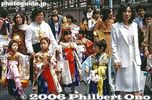
昔の築地本願寺の花まつりApr 10, 2006
|
|
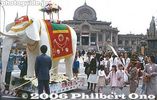
昔の築地本願寺の花まつりApr 10, 2006
|
|

Look at all those Cub Scouts. They don't participate today. 昔の築地本願寺の花まつりApr 10, 2006
|
|

Buddhist flag. 昔の築地本願寺の花まつりApr 10, 2006
|
|
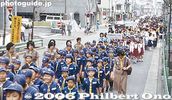
The chigo parade of bygone days was much longer with a lot more kids. 昔の築地本願寺の花まつり: かなり長い行列でした。Apr 10, 2006
|
|
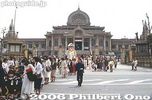
A very long hanamatsuri parade leaves the temple. 昔の築地本願寺の花まつり: 集合は別院内、これは出発。Apr 10, 2006
|
|

昔の築地本願寺の花まつりApr 10, 2006
|
|
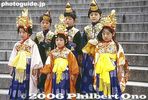
Chigo children. 昔の築地本願寺の花まつりApr 10, 2006
|
|
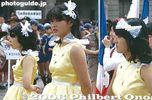
昔の築地本願寺の花まつり: 日大のバトン部かApr 10, 2006
|
|

Hanamatsuri in the old days (lot more children and people). 昔の築地本願寺の花まつり: 子供の数が大多かった。Apr 10, 2006
|
|
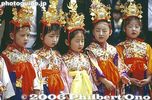
Chigo children. They have two black dots on the forehead and a white stripe on the nose. They don't paint the white stripe today. 昔の築地本願寺の花まつり: 鼻に白い線が塗っている。今は、塗らない。Apr 10, 2006
|
|
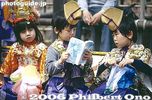
Chigo children. 昔の築地本願寺の花まつりApr 10, 2006
|
|

Chigo children. 昔の築地本願寺の花まつりApr 10, 2006
|
|
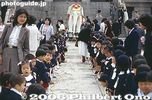
Many little kids held a long rope to pull the white elephant. 昔の築地本願寺の花まつりApr 10, 2006
|
|

Oedo Sukeroku Taiko troupe. They were all girls and super good!大江戸助六太鼓Apr 10, 2006
|
|

Beating backward: Oedo Sukeroku Taiko drummers大江戸助六太鼓Apr 10, 2006
|
|

Oedo Sukeroku Taiko troupeApr 10, 2006
|
|

Oedo Sukeroku Taiko troupe大江戸助六太鼓Apr 10, 2006
|
|

Oedo Sukeroku Taiko troupe大江戸助六太鼓Apr 10, 2006
|
|

The white elephantApr 10, 2006
|
|

Taiko drum performance by Oedo Sukeroku Taiko troupe. 大江戸助六太鼓Their Web site: http://www.oedosukerokutaiko.com/
大江戸助六太鼓Apr 10, 2006
|
|

Apr 10, 2006
|
|

Temple hall exteriorApr 10, 2006
|
|

Playroom for kidsApr 10, 2006
|
|

Apr 10, 2006
|
|

Apr 10, 2006
|
|

Statue of St. Shinran (1173-1263), founder of the Jodo Shinshu (Pure Land) Buddhist Sect.Apr 10, 2006
|
|

Cherry blossoms and the templeApr 10, 2006
|
|

Pipe organsApr 10, 2006
|
|

Outdoor food courtApr 10, 2006
|
|

Statue of St. Shinran, founder of Jodo Shinshu sect.Apr 10, 2006
|
|

Praying to the Hanamatsuri altarApr 10, 2006
|
|

Chigo kids enter the templeApr 10, 2006
|
|

Hanamatsuri service inside the templeNotice the Hanamatsuri altar at the center.Apr 10, 2006
|
|

Hanami-do housing a statue of the baby Buddha on which sweet tea is poured. When the Buddha was born in Lumbini Garden, flowers bloomed.Apr 10, 2006
|
|

The elephant follows the band.Apr 10, 2006
|
|

Hanamatsuri service inside the Tsukiji Hongwanji templeApr 10, 2006
|
|

The parade was over after 30 min. (11:30 - 12 pm).Apr 10, 2006
|
|

Entering the temple gateApr 10, 2006
|
|

Final performanceApr 10, 2006
|
|

Baton-twirling club, Tsukiji Hongwanji, Tokyo 千代田女学院 バトン部千代田女学院Apr 10, 2006
|
|

On the road in front of the templeApr 10, 2006
|
|

Band from the Chiyoda Jogakuin Girls Junior/Senior High SchoolNo problem photographing them.Apr 10, 2006
|
|

Female schoolmates of the baton twirlers block the cameras of unrelated photographers when the baton twirlers passed. カメラ小僧を妨害するバトン部の先輩たち。This was the first time for me in Japan to see people blocking photographers from taking pictures at a festival. They did it to me as well. If they don't want to be photographed, why do they appear in this public festival??
妨害しても無駄だと思いますが。撮られるのがいやでしたら、まつりに出ない方がいいですよ。Apr 10, 2006
|
|

Start of the Hanamatsuri parade which also promotes traffic safety.The starting point was a nearby park.Apr 10, 2006
|
|

Parade starts...Apr 10, 2006
|
|

Chigo childrenApr 10, 2006
|
|

Baton-twirling club from the Chiyoda Jogakuin Junior/Senior High School followed by the elephant千代田女学院Apr 10, 2006
|
|

White elephant to anchor the parade. Notice the Buddha altar riding on the top. Before she gave birth to the Buddha, Queen Maya dreamed of a white elephant.Apr 10, 2006
|
|

Children dressed for the chigo parade, Tsukiji Hongwanji, TokyoIt took a long time before they could get all the kids to settle down for the picture and to get all the mothers out of the picture.Apr 10, 2006
|
|

Children dressed for the chigo parade (photo session), Tsukiji Hongwanji, TokyoApr 10, 2006
|
|

Going to the chigo parade's starting pointApr 10, 2006
|
|

Pouring sweet tea over the BuddhaWhen the Buddha was born in Lumbini Garden in Nepal, sweet rain is said to have fallen. Thus, sweet tea is poured over the baby Buddha statue in the Hanamatsuri altar.Apr 10, 2006
|
|

Hanamatsuri altarApr 10, 2006
|
|

Baby Buddha statueLadles are provided for pouring the sweet tea over the Buddha. Sweet tea is also provided to worshippers. It symbolizes the sweet rain that fell when the Buddha was born.Apr 10, 2006
|
|

Hanamatsuri celebrates the Buddha's birthday on April 8. This is Tsukiji Honganji in Tokyo.The flowers symbolize Lumbini Garden where the Buddha was born in present-day Nepal.Apr 10, 2006
|
|

Established in 1617, Tsukiji Hongwanji temple is the Tokyo headquarters of the Nishi Hongwanji Jodo Shinshu sect. The present temple, based on Indian architecture, was built in the 1930s.The temple is the only one in Japan which is under the direct control of the sect. Its head priest is the Monshu Abbot himself. April 8 is observed as Buddha's birthday, called Hana Matsuri ("Flower Festival) in Japan.Apr 10, 2006
|
|

Tsukiji Hongwanji temple gate with wisteria crest.The emblem is a wisteria flower and symbol of the Jodo Shinshu sect.Apr 10, 2006
|
|

Temple gate and flagApr 10, 2006
|
|

Play room for kids on HanamatsuriApr 10, 2006
|
|
|
|
|
|